in the Scotts Creek Watershed
along the California Coast 20 miles north of Santa Cruz
50 to 200 feet elevation
report by Connie Barlow
June 15, 2005
(with interpretive assistance of Lee Klinger)
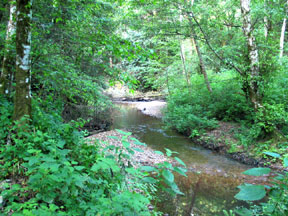
Scotts Creek
50 to 200 feet elevation
report by Connie Barlow
June 15, 2005
(with interpretive assistance of Lee Klinger)

Scotts Creek
CONNIE BARLOW undertook this Torreya quest in the Scotts Creek Watershed (accessed via Swanton Road, from California Rte. 1) with the assistance of Scotts Creek resident and botanical expert Jim West and ecologist, tree-healer Lee Klinger of Big Sur (Lee's website for his professional healing of trees is "Sudden Oak Life" www.SuddenOakLife.org).
A NOTE ON PRIVATE LANDS. All the lands in the Scotts Creek Watershed are privately owned. Local resident Jim West made our visit possible, by obtaining permission from the landowners in advance. The private lands we visited are now owned by California Polytechnic University.
A NOTE ON FAVORABLE QUALITIES OF Scotts CREEK WATERSHED: Scotts Creek watershed has lush and vibrant populations of California Torreya, including the State Champion California Torreya and many other large specimens. It also contains the State Champion California Buckeye. Although the elevation of torreyas that we visited was only between 50 and 200 feet, Torreya habitat here entails fog-shrouded ravines and creek terraces, less than 5 miles inland from cold ocean waters, and in a pocket that generates more rain than surrounding landscapes in the Santa Cruz area. Also, the geology is easily eroded mudstones and the geomorphology includes ravines with very steep slopes, which makes the area susceptible to slumpage and landslides, which may be favorable for opening up the forest canopy so that stump sprouts of Torreya may shoot up into reproductively active trees.
Jim West, who has been studying the vegetation of this watershed for more than 40 years, has estimated that patchily over 5 or 6 thousand acres, this watershed supports from 1800 to 2600 Torreya specimens of an age class 15 years or older. To learn more about the unusually rich diversity of plant life in this watershed, visit the Scotts Creek Watershed website.
1. Slope Habitats (in tributary ravines)
Jim West led Connie Barlow and Lee Klinger a short distance up a narrow ridge (former logging road) between two ravines that drained into Scotts Creek. Saplings were rather common on this ridge, but the large trees were visible growing from the steep slopes that dropped off both sides of the ridge.
1a
1b
PHOTO 1a & 1b: Lee Klinger touching the top of a vibrant young Torreya, growing in a sunny patch, thanks to a recent treefall of a Monterey Pine (at right), many of which were dead or ailing on this hike. Another small Torreya is visible in the sunlight, center foreground of Photo 1a. Lee is standing in a profusion of poison oak.
2a
2b
2c
PHOTO 2a, 2b, 2c: This very large Torreya was growing about 40 feet downslope from the narrow ridge between 2 ravines on which we were walking. It is isolated from other trees, surrounded by sword fern and poison oak. It has a full canopy, but shows signs of "bleeding" along a crack (by Lee's fingers). I recall it is a male. But on the exact opposite side of the ridge (in the other ravine, which was far too steep to descend into) were several very tall females profusely fruiting. You can see the steep grade of the slope in photo 2b.
2. Swanton Station (flat, alluvial, highly developed area)
3a
3b
PHOTO 3a & 3b: Lee climbs a female Torreya growing right next to a paved road within the "Swanton Station" grounds. In photo 3b, the road (and a rail) are visible at the bottom left; the torreya itself is the largest trunk visible to the left of the pile of rails. Notice two fruit-laden branches on its right and left, hanging all the way down, sprawling out onto the ground.
3c
3d
PHOTO 3c & 3d: A fruit-laden branch of this "Swanton Station" torreya. Aborted fruit (3b) were evident beneath torreyas bearing abundant fruit. This fruiting season had been preceded by an unusually rainy winter and spring.
3e
3f
PHOTO 3e & 3f: Immature fruit on the branch, and sliced through. The green is the fleshy sarcotesta which remains soft as the seed ripens. The orange and white section will eventually harden into a very large and thinly shelled seed (with a shell like that of a pine nut). This large seed is capable of supporting the early growth of a seedling in locations far too shady for small-seeded conifers (like Douglas Fir and Redwood) to establish.
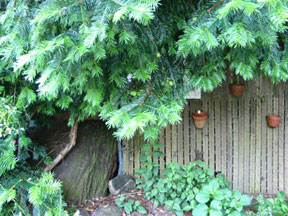
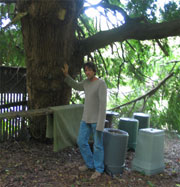
PHOTO 4a & 4b: A fruit-bearing giant female Torreya, growing well in a highly disturbed habitat in the Swanton Station compound.
5a
5b
5c
PHOTO 5a, 5b, 5c: A dying large Torreya at Swanton Station, with most of its branches leafless, especially the upper ones. This was THE ONLY OBVIOUSLY DYING SPECIMEN of Torreya I encountered in the Scotts Creek watershed. Close-up of its trunk, with a low branch in foreground that bears basally yellowing leaves. The cause of the ailment was not obvious, and residents told us that the Phytophthora pathogen (to which sudden oak death is attributed by some) has not yet appeared in the Scotts Creek watershed. Jim West offered that this particular tree was growing in a spot in which heavy vehicles routinely transit on both sides of it; thus soil compaction may have been a factor. Lee Klinger postulated that, as with sudden oak death, the ultimate cause is probably root destruction attributable to acidifying soils in habitats that have not recently been fired or fortified with mineral supplements (crushed shell or limestone). Trees stressed by acidified soils are consequently more susceptible to a variety of ills.
6a
6b
PHOTO 6a & 6b: The State Champion California Buckeye, abundantly in bloom, at Swanton Station.
3. Flat River Terrace Habitat
along the main course of Scotts Creek(undeveloped, except for paved road and an old logging road on opposite side of the creek)
7
8
PHOTO 7: Lee is standing by a large Torreya, beyond a multi-stemmed bay laurel growing out of an old lignotuber. (The bay tree is amplified in size by the telephoto lens.) Although the Torreya has dead, moss-covered lower branches, its tall canopy looked healthy from a distance.PHOTO 8: Two large Torreyas alongside the paved road (flash photo). The left, leaning Torreya has a canopy that reaches left, too, away from the tall straight and larger Torreya to its right.
9a
9b
9c
PHOTO 9a, 9b, 9c: A Torreya so recently fallen that its branches are still in leaf. Notice the dense coating of moss on the trunk. Lee suspects that rainwater percolating down through the moss was acidified to such an extent that root rot (photo 9b) undermined the tree. Notice the gray, mineral-leached soil in the lower right corner of 9b. Photo 9c shows the forest context, and the fallen Torreya blocking the trail.
10a
10b
10c
PHOTO 11a, 11b, 11c: The SECOND LARGEST Torreya I have seen in California. It has a circumference at breast height of 125 inches, and Lee estimated its height as 80 feet tall. This one was fruitless, though its canopy (the conical peak in Photo 10c) was in full sunlight, so I am sure it is a male. Above Lee's hand in Photo 10b, the tree is healing folds over a previous wound from fire or tool-handle harvesting by Native Americans.
12
13
PHOTO 12: Another large Torreya, growing alongside the old logging road (actually a railroad), which Lee is standing on.PHOTO 13: An aborted Torreya fruit near a banana slug on the old logging road.
14a
14b
PHOTO 14a & 14b: Road-edge vegetation along the Swanton Road, the only road heading up the narrow valley of Scotts Creek. The road is built on a flat river terrace at this section, which ends where the right-side vegetation begins, as that is the base of a steep slope. The small flowering tree is a California Buckeye, and right next to it is a thriving Torreya (close view of both in Photo 14b). This association refutes (at least in this foggy, coast-range valley) Connie's previous hypothesis (based on her Sierra experiences with Torreya) that Torreya always is found at elevations higher than where one finds California Buckeye. Nonetheless, her hypothesis that Torreya seedlings, saplings, and larger trees will not be found in places where there are abundant young Douglas Fir seems to have held up well in the Coast Range, as well as in the Sierras. Seedlings and resprouting Torreya may, however, be found in association with old, upper-canopy Douglas Fir, as well as growing near tall redwoods, oaks, bay laurels, and pines. Like most other trees, Torreya loves full sunlight, but rarely can it expect to get it in the wild except for post-fire and tree fall episodes or thanks to slumping and eroding steep slopes.
15a
15b
PHOTO 15a & 15b: Connie with the STATE CHAMPION CALIFORNIA TORREYA! Because Torreya californica is native only to California, this tree is also the largest California Torreya on the planet. We measured its circumference at breast height as 254 inches, which is close to that reported on the internet in the "California Register of Big Trees" and dated as having been measured in 1993 (251 inches). Although this champion tree is listed as 96 feet tall, it did not appear to us to be as tall as the second-widest tree we visited. Lee visually estimated the height of this one (Photo 15b) as only 60 feet.
15c
15d
15e
PHOTO 15c, 15d, 15e: The state champion tree is ailing. Although not overtopped or crowded by any other tree, its canopy is not nearly as full as that of the second-largest Torreya, and it has large debarked sections. (Fruitless, it seems to be a male.) Photo 15c shows where the tree is curling a fold of living wood and bark over a previous wound (which is the large white patch in Photo 15a toward the left side of the trunk on a plane with Connie's hand). But notice how in 15d a new crack has opened in that very fold, and is thus vulnerable to fungal spore entry. Photo 15e shows where the trunk divides into two or more stems, about 15 feet above ground level. We (and Jim West) could not discern whether this fork represented a divide in a single original stem or whether two stems eventually grew together. Notice the dense moss on the trunk, which carpets the "top" side of the leaning trunk. One would expect intense acidification of the upslope roots, where rainwater percolating down the mossy expanse meets soil. Indeed, Connie felt around the base of the two structural roots on the upslope side, where each plunged into the soil, and she was alarmed to discover that one of the two was already severely compromised: big chunks of moss-covered wood pulled off with barely a touch. Lee Klinger believes that the same techniques (liming) that he has used to HEAL big oak trees suffering from "sudden oak death" can be used to heal and safeguard this champion tree.UPDATES ON THE FATE OF THE ABOVE SWANTON CHAMPION TREE:
April 2015 Connie got word online that the state champion torreya pictured above is officially DEAD. I do hope that someone cores the tree to determine its age, the forest history (based on ring width), and whether it is a 2-stem or 1-stem individual. • 3 January 2016 email from Frank Callahan: Email from Steve Auten and National Champion nomination by Frank Callahan (1992). The critical measurements are: just under 21' in circumference @ 4.5" - 96' tall - crown spread = 68' - Total points = 364. Steve Auten reports the age from this single trunk tree to be 230-250 years old, however the center 12" is rotten.• 15 December 2016 email from Frank Callahan: "Here is the data on the former National Champion Torreya californica at Swanton. It was just one tree not conjoined trunks! This is not an old tree: probably 250 years, considering the rotten center." Frank's email contained a string of emails among Steve Auten (Ranch Operations Manager, Swanton Pacific Ranch, College of Agriculture, Cal Poly State University), Jim West, and others. Auten reported in an email to Frank dated 15 March 2016: "We did cut the Torreya. It was one tree [not 2 stems]. Varied fire damage with rotten center. Rotten diameter is approximately 12 inches. Aged at approximately 250 and 230 years on two different counts (does not include any estimation of rotten center). Due to fire damage and compression/tension issues, the three rounds we cut broke into smaller sections."
NEW CHAMPION NAMED IN 2012: Excellent photos of new champion in Big Basin State Park (on the northward side of the forest trees Connie visited in 2005) at this website. Stats on that page show a remarkable height of 105 feet, but circumference just 133 inches (compared to the previous champion of 251 inches).
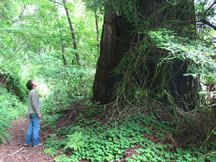 16
16
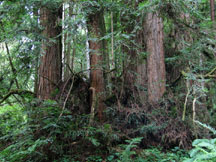 17
17
PHOTO 16: A giant Redwood Tree alongside the old logging road. This tree was passed over by the loggers because it is abundantly knotted just above the level of this photo and has low, gnarly branches.PHOTO 17: Redwood Temple. Telephoto shot from the logging road, across Scotts Creek, and focusing on a clump of large redwoods all rising from the same old and elevated lignotuber that rises sharply from the creekbed. This redwood "island" is perhaps 60 or 70 feet in its longest dimension. Two of the biggest stems were obviously worked by fire by the Native Americans, and both of the huge fire cavities provide good views of the creek. The fire injuries prompted those stems to flare out with reinforcing, fast-growing wood, thus strengthening their resistance to winds that might otherwise topple them. Lee Klinger found shell fragments at this site, which he regards as evidence that the original occupants of this valley tended these trees with lime sources as well as fire (not just flame but also smoke, as the smoke by itself kills acidifying moss).
Lee Klinger theorizes that most (and perhaps all) of the biggest oaks, redwoods, and sequoias in California were carefully tended by resident Native Americans who valued them for food, shelter, and spiritual sustenance. Tending the trees would have included using fire to foster butressing in redwoods and sequoias, and using a combination of flame, smoke, and lime (crushed shells, bones, and limestone) to prevent soil acidification and root rot. Liming probably would have extended up the trunk as well: a kind of white-washing of lower trunks, thus preventing the development of mosses in between fire episodes and ensuring that rainwater percolating down from mossy areas higher up is neutralized before reaching the roots. NOTE: "Heavy liming (especially gypsum) seems to be beneficial" for combating Phytophthora infected trees. (Source: http://www.treecrops.org.nz/knowl/addgen/phytoph.html).
Click here to access a PDF of Lee Klinger explaining the role of LIMING to combat SUDDEN OAK DEATH.
Click here to access Lee Klinger's "Sudden Oak Life" website: www.SuddenOakLife.org. Click for the 8 October 2005 article in the San Francisco Chronicle that features the ideas and work of LEE KLINGER on how to use lime to improve the health of trees struggling with Sudden Oak Death.
RETURN TO California Torreya Main Page